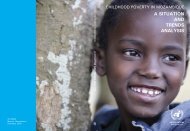Mozambican Civil Society Within: - UNICEF Mozambique - Home page
Mozambican Civil Society Within: - UNICEF Mozambique - Home page
Mozambican Civil Society Within: - UNICEF Mozambique - Home page
Create successful ePaper yourself
Turn your PDF publications into a flip-book with our unique Google optimized e-Paper software.
<strong>Mozambican</strong> <strong>Civil</strong> <strong>Society</strong> <strong>Within</strong>: Evaluation, Challenges, Opportunities and Action<br />
socio-economic inequality; 7) widespread adult illiteracy and 8) lack of information technology<br />
and communication infrastructure. The score for this indicator thus takes into account the<br />
number of conditions observed and their severity.<br />
Some relevant information on this topic is summarised below:<br />
Widespread poverty (over 40% of the population living on less than $2 a day): This condition<br />
applies to <strong>Mozambique</strong> that is still classified among the dozen poorest countries in the world -<br />
in 168 th place out of 177 countries (UNDP, 2006) and it is the least developed country in southern<br />
Africa. The most recent study on absolute poverty showed that poverty levels had fallen from<br />
67% in 1997 to 53% in 2003, but about 74% of <strong>Mozambican</strong>s continue to live on less than two<br />
dollars a day.<br />
<strong>Civil</strong> war (armed conflicts in the last five years): This condition does not apply to <strong>Mozambique</strong><br />
as the civil war ended in 1992.<br />
Serious ethnic and/or religious conflicts: This condition does not apply to the country<br />
Serious economic crisis (for example, external debt higher than GDP): This condition applies<br />
in part. The external debt represents $US 65 for every <strong>Mozambican</strong> and 45% of <strong>Mozambique</strong>’s<br />
GDP. Under these circumstances the condition would not apply. However, there is strong<br />
concern about evidence showing a tendency for the foreign debt to increase cyclically, and that<br />
it is being controlled more through debt forgiveness than through growing economic<br />
independence. Moreover, with rising migration to urban areas that is not accompanied by a<br />
proportional growth in jobs, social and economic tension is increasing in urban centres such as<br />
Maputo city. In addition, at this level serious economic crisis appears to be latent, but with a<br />
tendency to get worse.<br />
Serious social crisis (in the last two years): Despite relative social stability, high levels of<br />
poverty, rising malnutrition or food insecurity in some parts of the country, the impact of various<br />
epidemics such as HIV/AIDS, when taken together can be considered evidence of serious<br />
social crisis.<br />
Serious socio-economic inequality (Gini coefficient > 0.4): In the last study on poverty by INE<br />
in 2003, the estimate of the Gini coefficient was over 0.4. UNDP recently estimated the Gini<br />
coefficient to be 0.573.<br />
Widespread illiteracy (over 40 percent): The estimate of INE and UNDP is an illiteracy rate of<br />
52.8%.<br />
Lack of Information Technology Infrastructure (i.e. less than five Internet services for 10,000<br />
inhabitants): This condition applies to <strong>Mozambique</strong>, that in 2007 had less than two hundred<br />
thousand people with access to the Internet, corresponding to less than one user per 100<br />
inhabitants. (http://www.internetworldstats.com).<br />
<strong>Civil</strong> <strong>Society</strong> Index, <strong>Mozambique</strong> 2007<br />
53
















